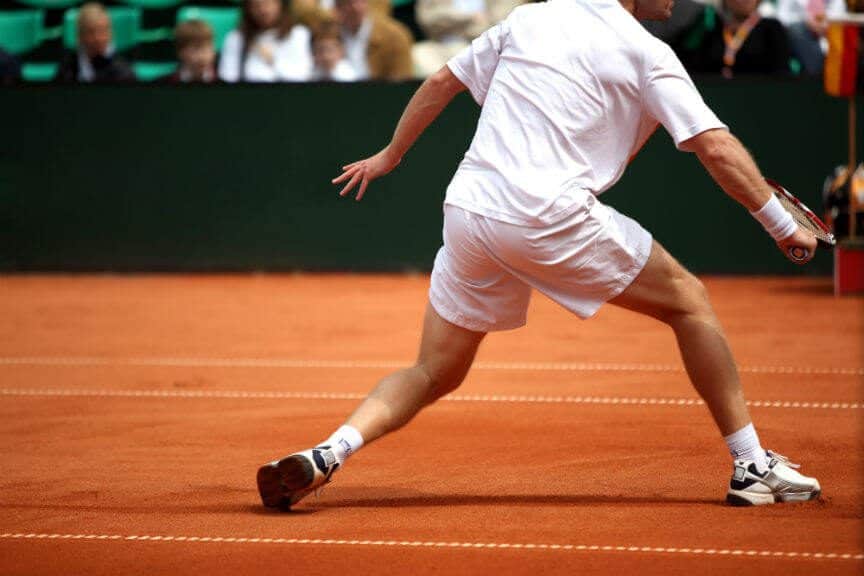Selecting the Right Pair of Tennis Shoes
While you don’t necessarily have to spend a fortune on the latest style or trend in tennis shoes, it is important to invest in a pair that will provide adequate lateral support. This is one investment you don’t want to skimp on. You want to avoid injury and potential foot problems down the road.
You also want to avoid the mistake some people make of using running shoes on the tennis court. They are designed for forward motion and will not provide the necessary support for lateral movement. A good pair of tennis shoes, in turn, will provide adequate support, comfort, and durability.
Anatomy of a Tennis Shoe
There are two main components of a tennis shoe: the upper portion, which wraps above and around the foot, and the sole. The sole is comprised of a midsole that provides cushioning and an outsole which is the part of the shoe that comes in contact with the court surface.
The upper portion of a shoe is broken up into 4 sections: the heel, the midfoot, the forefoot, and the toe box. The heel typically contains a solid back portion for heel support and an ankle collar to stabilize the ankle. The heel is also elevated in tennis shoes relative to the forefoot portion.
The midfoot portion provides critical lateral support. The midfoot also usually contains a cushioning system for lateral stability on the two sides of the shoe: the lateral (outside) and medial side (inside).
The forefoot portion prevents the shoe from deforming during lateral movement. This helps support the foot and keep it inside the shoe during abrupt stop and go. The top portion is called the vamp. It’s the most flexible portion of the shoe and allows the foot to breathe.
The toe box portion of the shoe keeps the toes in place and allows for some movement of the toes. At the front tip of the toe box is the toe guard, an added piece of durable material that is designed to protect you from toe dragging.
While leather was once the upper material of choice, most modern tennis shoes today are made from synthetic materials. This typically includes a blend of mesh with rubber thermoplastic polyurethane (TPU). The combination of these materials results in shoes that are lightweight and breathe well.
Insole, Midsole, and Outsole Area
Insoles provide the cushion and comfort on the soles of your feet that you come to expect in a good pair of tennis shoes. Midsoles offer additional cushioning and help absorb impact. Usually, the heal portion of the midsole contains the largest amount of cushion.
The outsole of the tennis shoe is the portion of the sole that is in contact with the court surface. It provides grip during stop-and-go movement. Shoes that are used on clay surfaces typically have very deep grooves in a herringbone pattern. Hardcourt surface soles usually have a modified herringbone pattern and less depth in the grooves.
Soles can be either one-piece, typically used on clay surfaces, or two-piece with a midfoot shank. The midfoot shank provides support against torsion and transfers the flex point to the front of the shoe.
What to Look For in a New Pair of Tennis Shoes
When trying on a new pair of tennis shoes, you want to make sure they fit your feet well. Check the fit around the middle of the shoe, you want them to be a bit snug for support, but not too tight. The heel should also feel snug for support but not uncomfortably tight. Heel support is important to avoid rolling an ankle.
Lastly, check the toe box for fit. While less critical, you don’t want your toes to feel tight or uncomfortable. You also don’t want the toe box to feel too loose where the front of your feet will move around too much.
Most modern shoes are designed with materials that require very little break-in. The uppers on the shoe should feel comfortable pretty much out of the box. Leather uppers will require a longer break-in period, though they will eventually feel comfortable after this initial period.
Finding the Right Fit
Tennis shoe sizing is based on the length and width of your foot. Shoes that are too small are either too short or too narrow. This is often the most common reason for foot pain and other problems.
On the other hand, shoes that are either too wide or too long can result in your feet sliding around too much and cause blisters and a lack of stability. The best-fitting shoes are neither too tight nor too loose.
When trying on a new pair of shoes, the best time to do so is at the end of the day when your feet are the largest. At the same time, you should try the shoes on with the socks you plan to use during play.
Typically, one of your feet will be slightly larger than the other, size your shoes according to the larger of the two. Doing these things will help avoid selecting shoes that end up being too small for your feet.
Support vs Lightweight Shoes
Given the choice between support and lightweight, it’s usually best to opt for support. There are players however that prefer light shoes because they allow for quicker foot movement and less strain on the legs, particularly during long matches.[/column]
Another aspect of lightweight shoes is that they tend to be less durable than stability shoes. The uppers are usually thinner to allow them to breathe and flex better. They also tend to have less cushion and thickness on the underfoot.
Conclusion
Both lightweight shoes and stability shoes have their place on the tennis court. Each has its advantages and disadvantages. If you favor stability and support as well as durability and extra cushioning, then stability shoes are your best option.
If on the hand you want light and flexible shoes that provide adequate support but sacrifice a bit on durability, and underfoot cushioning, then your best option would be to go with lightweight shoes. Because lightweight shoes flex more, however, they will feel less supportive. This is something to keep in mind when making your selection.

